check engine ISUZU TROOPER 1998 Service Service Manual
[x] Cancel search | Manufacturer: ISUZU, Model Year: 1998, Model line: TROOPER, Model: ISUZU TROOPER 1998Pages: 3573, PDF Size: 60.36 MB
Page 601 of 3573
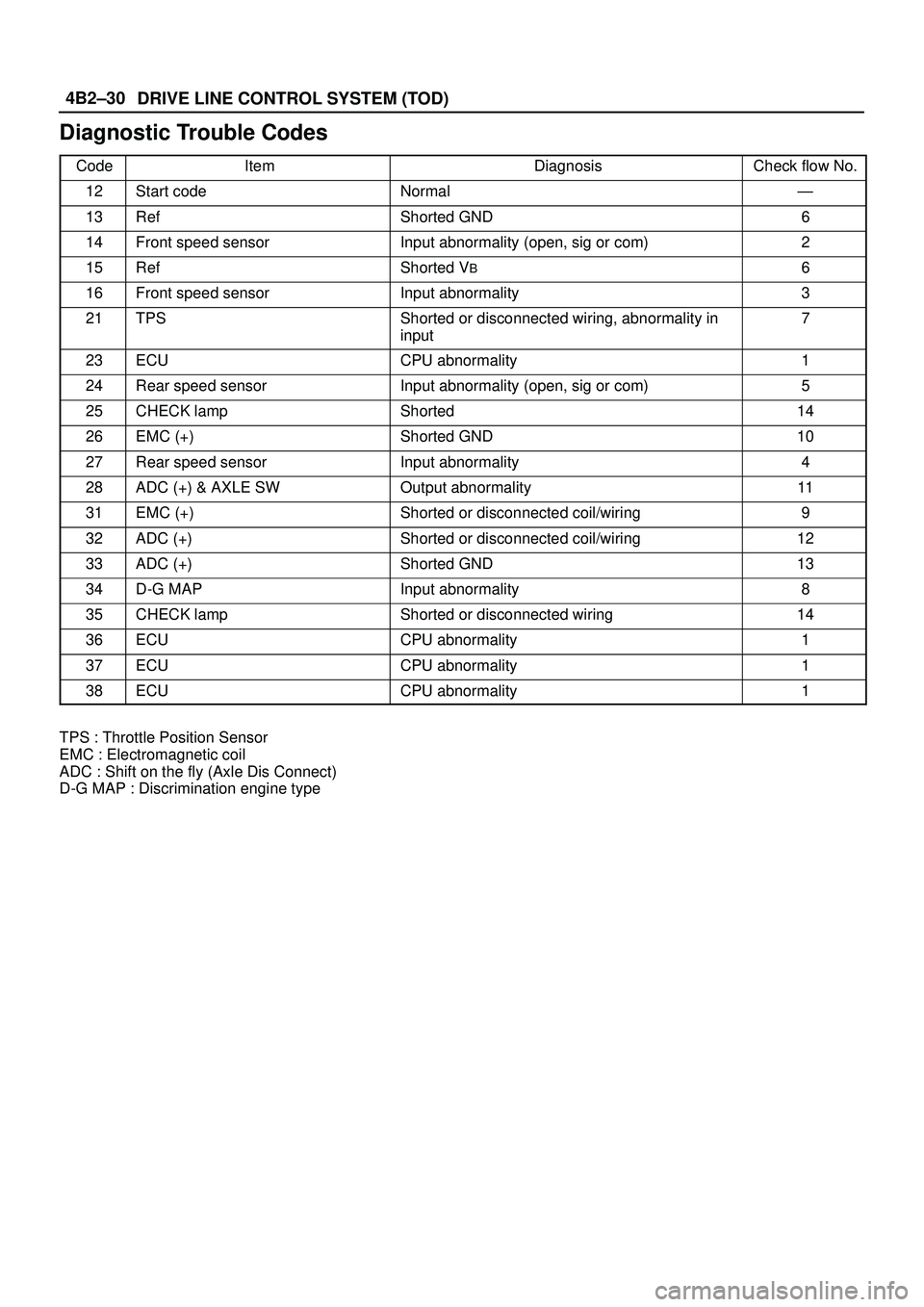
DRIVE LINE CONTROL SYSTEM (TOD) 4B2±30
Diagnostic Trouble Codes
CodeItemDiagnosisCheck flow No.
12Start codeNormalÐ
13RefShorted GND6
14Front speed sensorInput abnormality (open, sig or com)2
15RefShorted VB6
16Front speed sensorInput abnormality3
21TPSShorted or disconnected wiring, abnormality in
input7
23ECUCPU abnormality1
24Rear speed sensorInput abnormality (open, sig or com)5
25CHECK lampShorted14
26EMC (+)Shorted GND10
27Rear speed sensorInput abnormality4
28ADC (+) & AXLE SWOutput abnormality11
31EMC (+)Shorted or disconnected coil/wiring9
32ADC (+)Shorted or disconnected coil/wiring12
33ADC (+)Shorted GND13
34D-G MAPInput abnormality8
35CHECK lampShorted or disconnected wiring14
36ECUCPU abnormality1
37ECUCPU abnormality1
38ECUCPU abnormality1
TPS : Throttle Position Sensor
EMC : Electromagnetic coil
ADC : Shift on the fly (Axle Dis Connect)
D-G MAP : Discrimination engine type
Page 604 of 3573
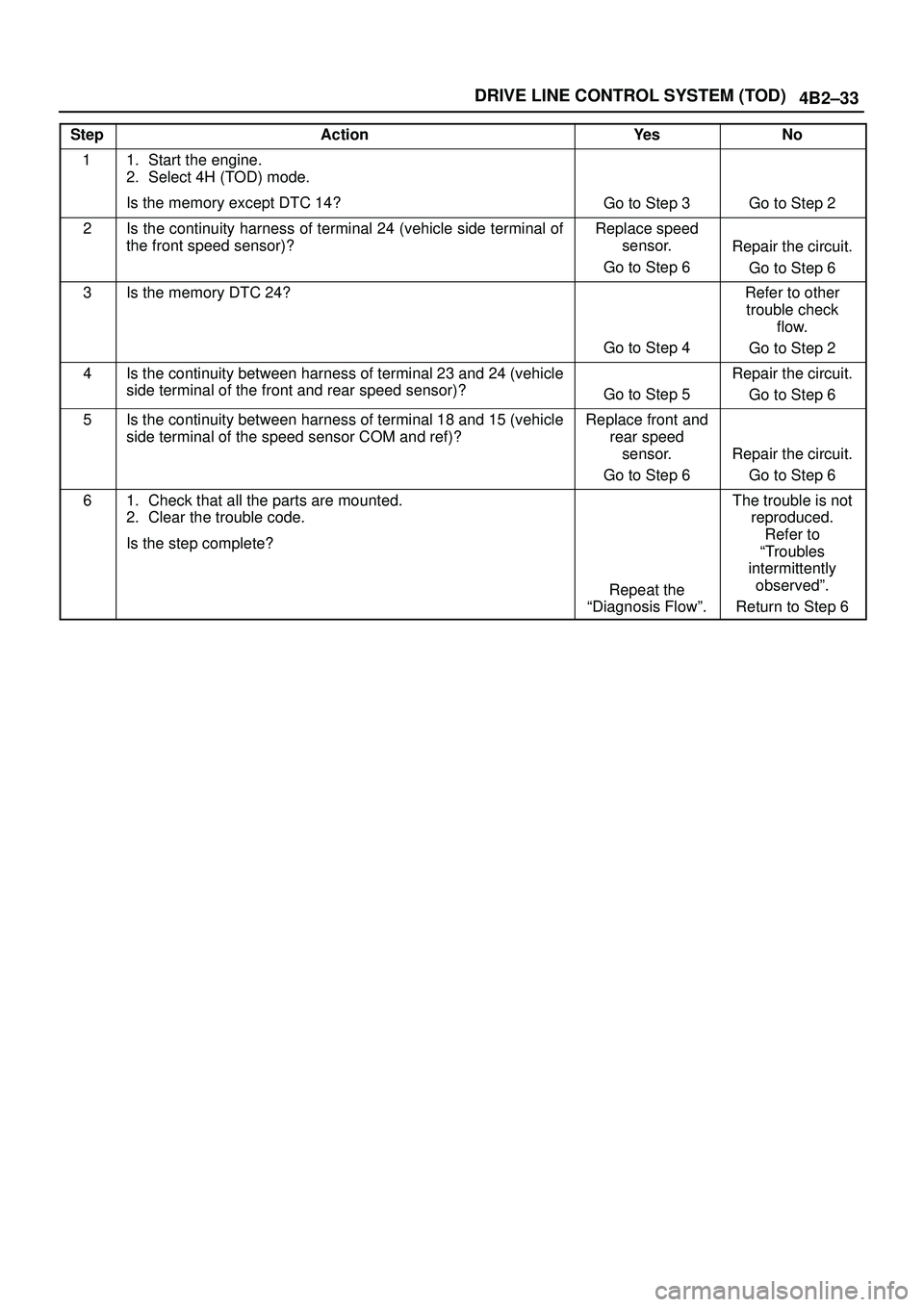
4B2±33 DRIVE LINE CONTROL SYSTEM (TOD)
StepActionYe sNo
11. Start the engine.
2. Select 4H (TOD) mode.
Is the memory except DTC 14?
Go to Step 3Go to Step 2
2Is the continuity harness of terminal 24 (vehicle side terminal of
the front speed sensor)?Replace speed
sensor.
Go to Step 6
Repair the circuit.
Go to Step 6
3Is the memory DTC 24?
Go to Step 4
Refer to other
trouble check
flow.
Go to Step 2
4Is the continuity between harness of terminal 23 and 24 (vehicle
side terminal of the front and rear speed sensor)?
Go to Step 5
Repair the circuit.
Go to Step 6
5Is the continuity between harness of terminal 18 and 15 (vehicle
side terminal of the speed sensor COM and ref)?Replace front and
rear speed
sensor.
Go to Step 6
Repair the circuit.
Go to Step 6
61. Check that all the parts are mounted.
2. Clear the trouble code.
Is the step complete?
Repeat the
ªDiagnosis Flowº.
The trouble is not
reproduced.
Refer to
ªTroubles
intermittently
observedº.
Return to Step 6
Page 610 of 3573
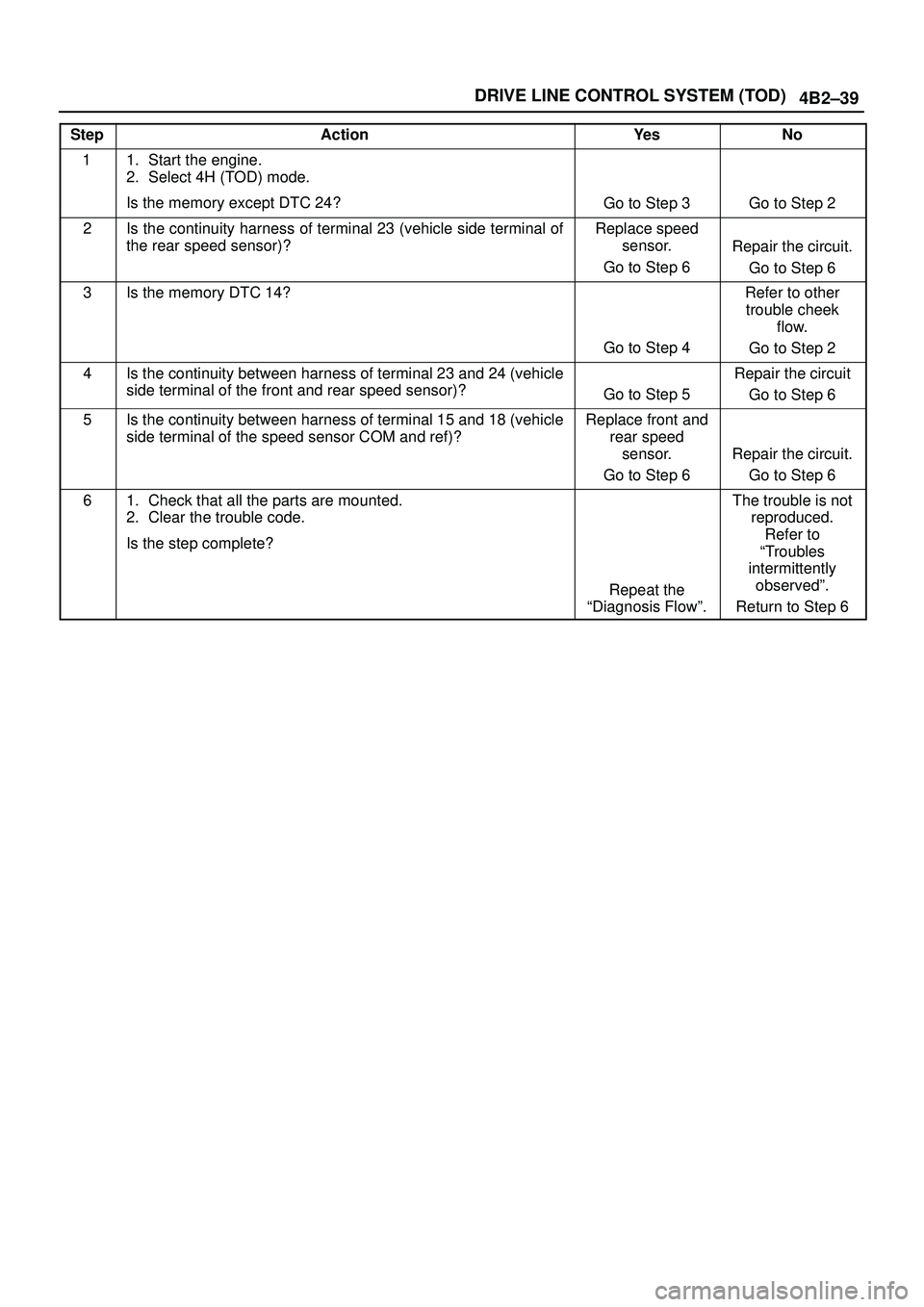
4B2±39 DRIVE LINE CONTROL SYSTEM (TOD)
StepActionYe sNo
11. Start the engine.
2. Select 4H (TOD) mode.
Is the memory except DTC 24?
Go to Step 3Go to Step 2
2Is the continuity harness of terminal 23 (vehicle side terminal of
the rear speed sensor)?Replace speed
sensor.
Go to Step 6
Repair the circuit.
Go to Step 6
3Is the memory DTC 14?
Go to Step 4
Refer to other
trouble cheek
flow.
Go to Step 2
4Is the continuity between harness of terminal 23 and 24 (vehicle
side terminal of the front and rear speed sensor)?
Go to Step 5
Repair the circuit
Go to Step 6
5Is the continuity between harness of terminal 15 and 18 (vehicle
side terminal of the speed sensor COM and ref)?Replace front and
rear speed
sensor.
Go to Step 6
Repair the circuit.
Go to Step 6
61. Check that all the parts are mounted.
2. Clear the trouble code.
Is the step complete?
Repeat the
ªDiagnosis Flowº.
The trouble is not
reproduced.
Refer to
ªTroubles
intermittently
observedº.
Return to Step 6
Page 612 of 3573
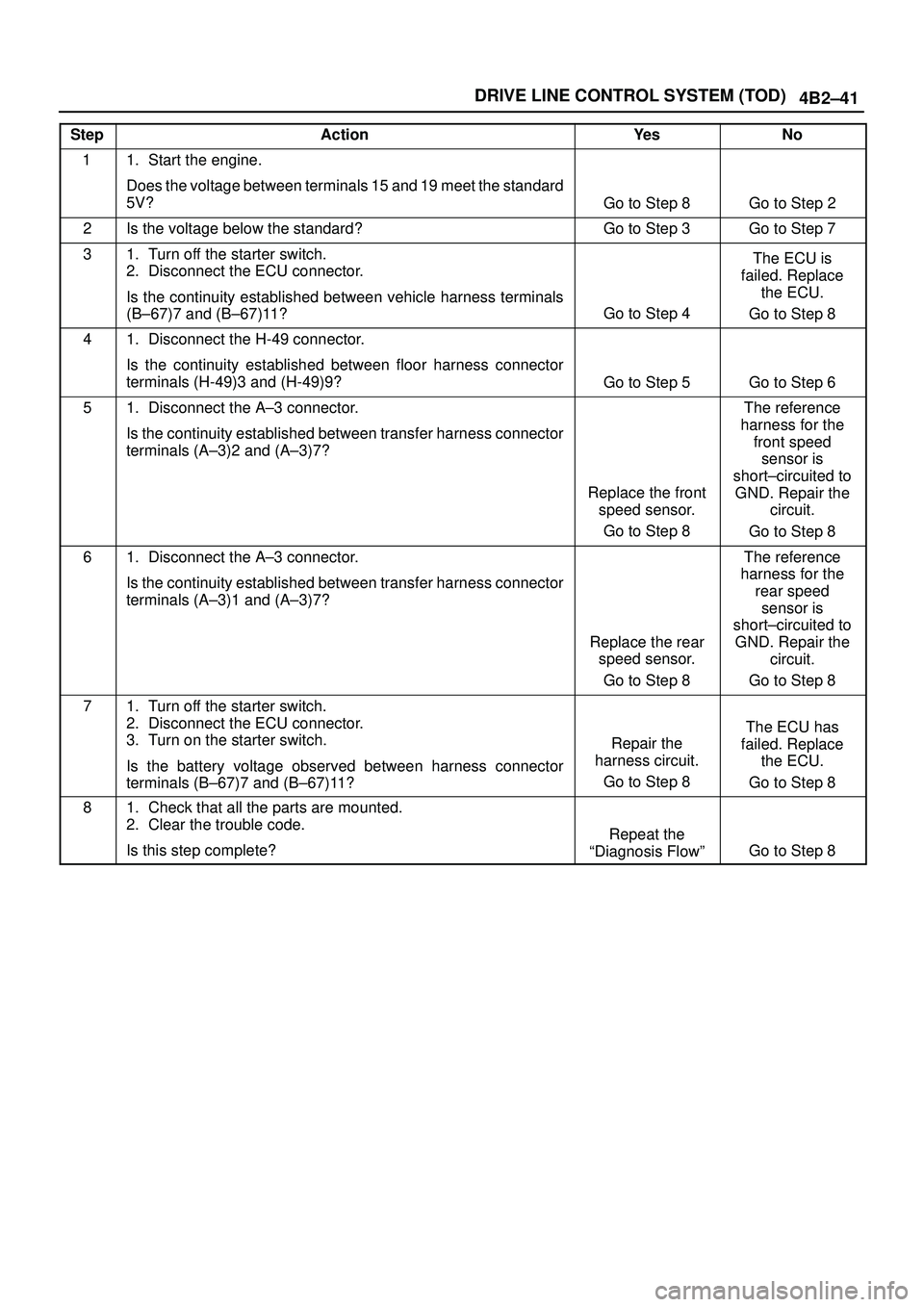
4B2±41 DRIVE LINE CONTROL SYSTEM (TOD)
StepActionYe sNo
11. Start the engine.
Does the voltage between terminals 15 and 19 meet the standard
5V?
Go to Step 8Go to Step 2
2Is the voltage below the standard?Go to Step 3Go to Step 7
31. Turn off the starter switch.
2. Disconnect the ECU connector.
Is the continuity established between vehicle harness terminals
(B±67)7 and (B±67)11?
Go to Step 4
The ECU is
failed. Replace
the ECU.
Go to Step 8
41. Disconnect the H-49 connector.
Is the continuity established between floor harness connector
terminals (H-49)3 and (H-49)9?
Go to Step 5Go to Step 6
51. Disconnect the A±3 connector.
Is the continuity established between transfer harness connector
terminals (A±3)2 and (A±3)7?
Replace the front
speed sensor.
Go to Step 8
The reference
harness for the
front speed
sensor is
short±circuited to
GND. Repair the
circuit.
Go to Step 8
61. Disconnect the A±3 connector.
Is the continuity established between transfer harness connector
terminals (A±3)1 and (A±3)7?
Replace the rear
speed sensor.
Go to Step 8
The reference
harness for the
rear speed
sensor is
short±circuited to
GND. Repair the
circuit.
Go to Step 8
71. Turn off the starter switch.
2. Disconnect the ECU connector.
3. Turn on the starter switch.
Is the battery voltage observed between harness connector
terminals (B±67)7 and (B±67)11?
Repair the
harness circuit.
Go to Step 8
The ECU has
failed. Replace
the ECU.
Go to Step 8
81. Check that all the parts are mounted.
2. Clear the trouble code.
Is this step complete?
Repeat the
ªDiagnosis Flowº
Go to Step 8
Page 615 of 3573
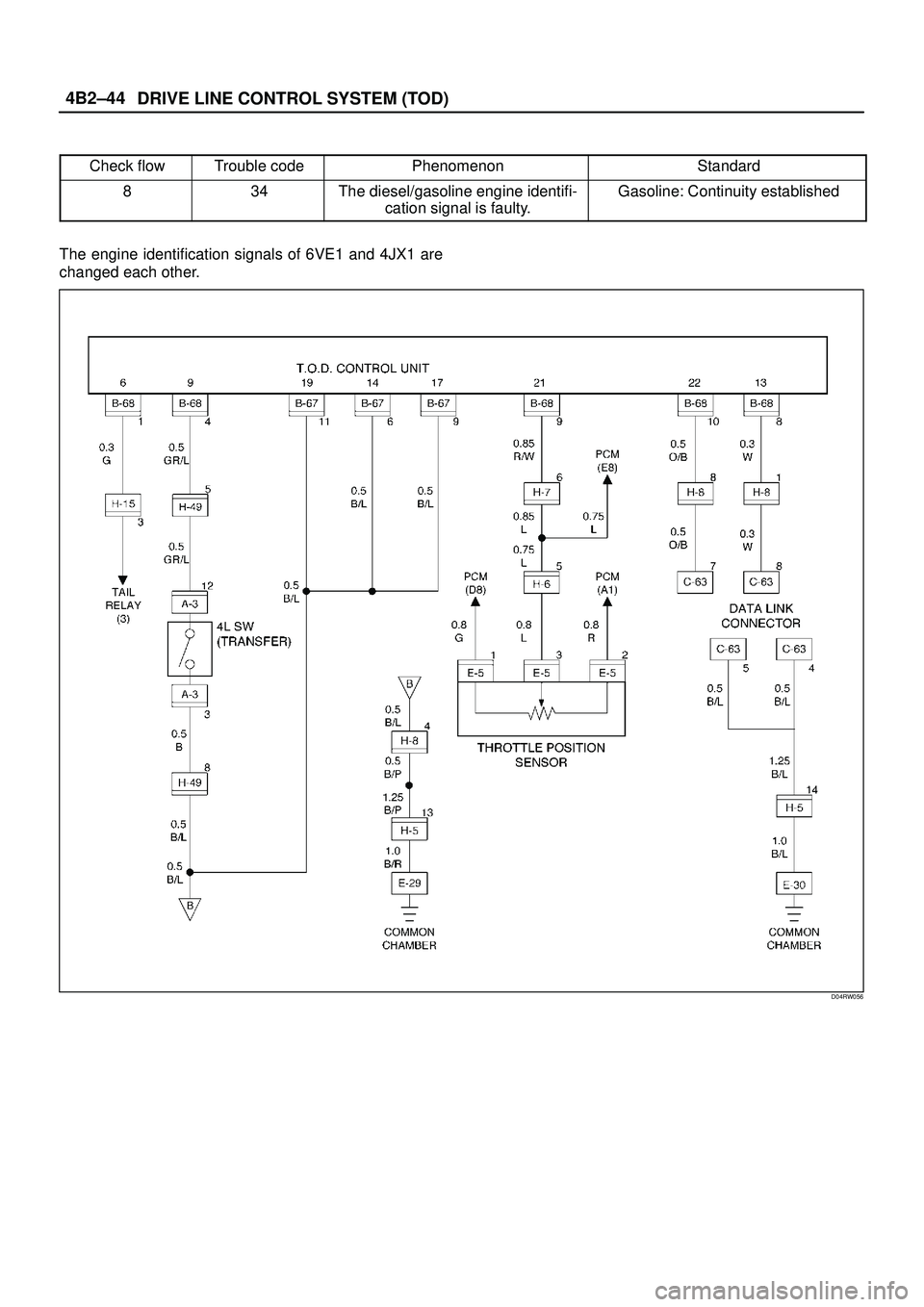
DRIVE LINE CONTROL SYSTEM (TOD) 4B2±44
Check flowTrouble codePhenomenonStandard
834The diesel/gasoline engine identifi-
cation signal is faulty.Gasoline: Continuity established
The engine identification signals of 6VE1 and 4JX1 are
changed each other.
D04RW056
Page 618 of 3573
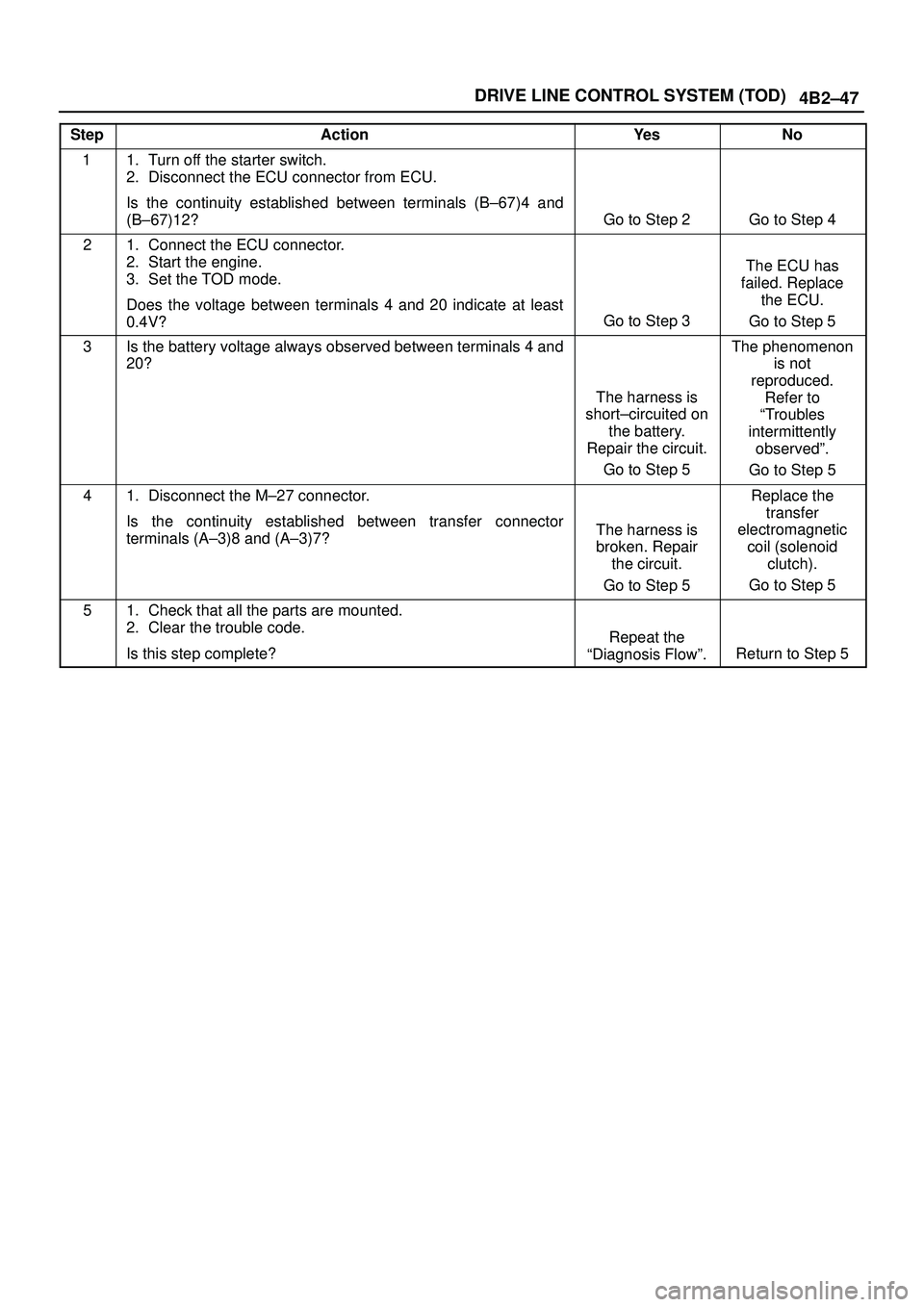
4B2±47 DRIVE LINE CONTROL SYSTEM (TOD)
StepActionYe sNo
11. Turn off the starter switch.
2. Disconnect the ECU connector from ECU.
Is the continuity established between terminals (B±67)4 and
(B±67)12?
Go to Step 2Go to Step 4
21. Connect the ECU connector.
2. Start the engine.
3. Set the TOD mode.
Does the voltage between terminals 4 and 20 indicate at least
0.4V?
Go to Step 3
The ECU has
failed. Replace
the ECU.
Go to Step 5
3Is the battery voltage always observed between terminals 4 and
20?
The harness is
short±circuited on
the battery.
Repair the circuit.
Go to Step 5
The phenomenon
is not
reproduced.
Refer to
ªTroubles
intermittently
observedº.
Go to Step 5
41. Disconnect the M±27 connector.
Is the continuity established between transfer connector
terminals (A±3)8 and (A±3)7?
The harness is
broken. Repair
the circuit.
Go to Step 5
Replace the
transfer
electromagnetic
coil (solenoid
clutch).
Go to Step 5
51. Check that all the parts are mounted.
2. Clear the trouble code.
Is this step complete?
Repeat the
ªDiagnosis Flowº.
Return to Step 5
Page 620 of 3573
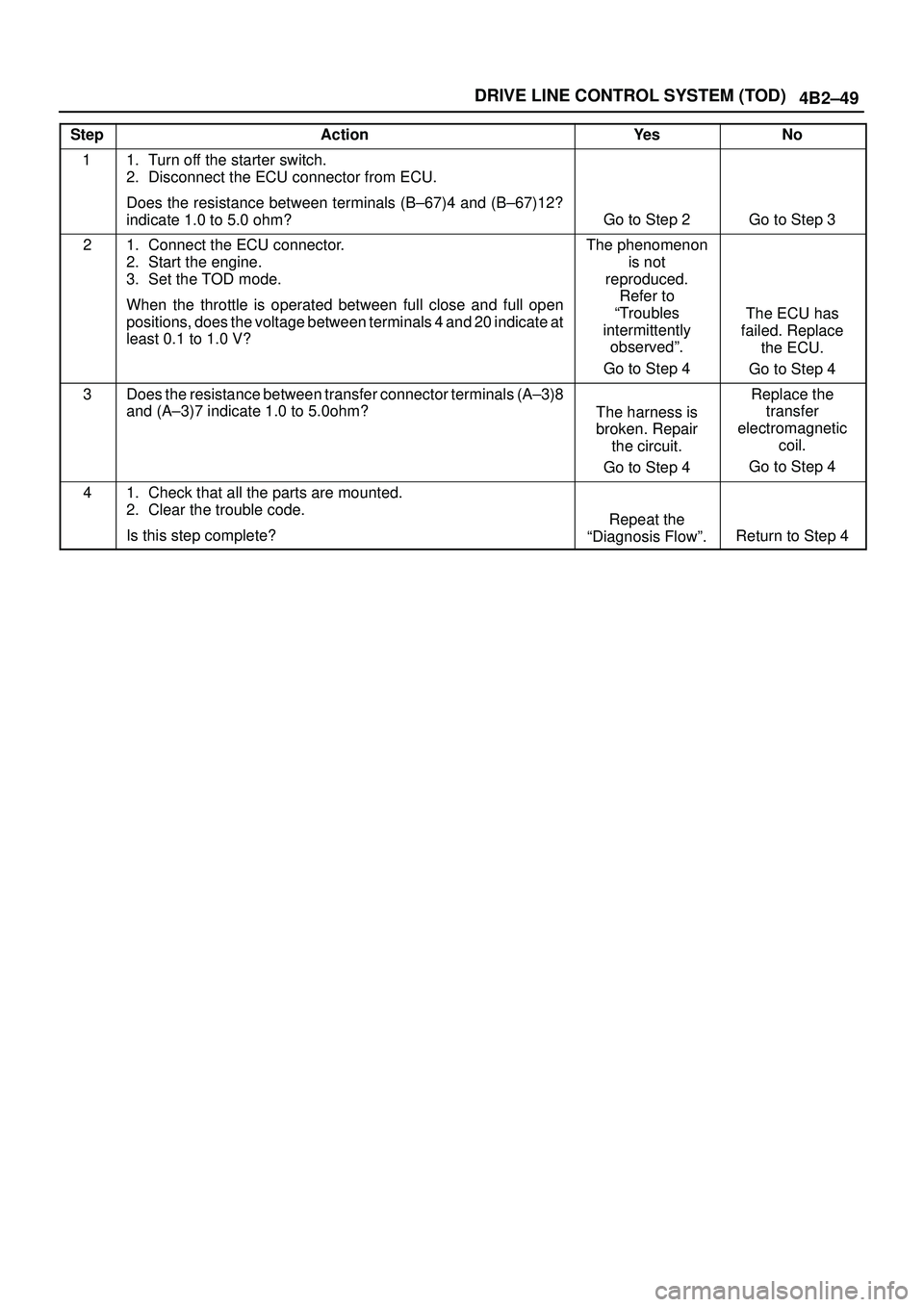
4B2±49 DRIVE LINE CONTROL SYSTEM (TOD)
StepActionYe sNo
11. Turn off the starter switch.
2. Disconnect the ECU connector from ECU.
Does the resistance between terminals (B±67)4 and (B±67)12?
indicate 1.0 to 5.0 ohm?
Go to Step 2Go to Step 3
21. Connect the ECU connector.
2. Start the engine.
3. Set the TOD mode.
When the throttle is operated between full close and full open
positions, does the voltage between terminals 4 and 20 indicate at
least 0.1 to 1.0 V?The phenomenon
is not
reproduced.
Refer to
ªTroubles
intermittently
observedº.
Go to Step 4
The ECU has
failed. Replace
the ECU.
Go to Step 4
3Does the resistance between transfer connector terminals (A±3)8
and (A±3)7 indicate 1.0 to 5.0ohm?
The harness is
broken. Repair
the circuit.
Go to Step 4
Replace the
transfer
electromagnetic
coil.
Go to Step 4
41. Check that all the parts are mounted.
2. Clear the trouble code.
Is this step complete?
Repeat the
ªDiagnosis Flowº.
Return to Step 4
Page 659 of 3573
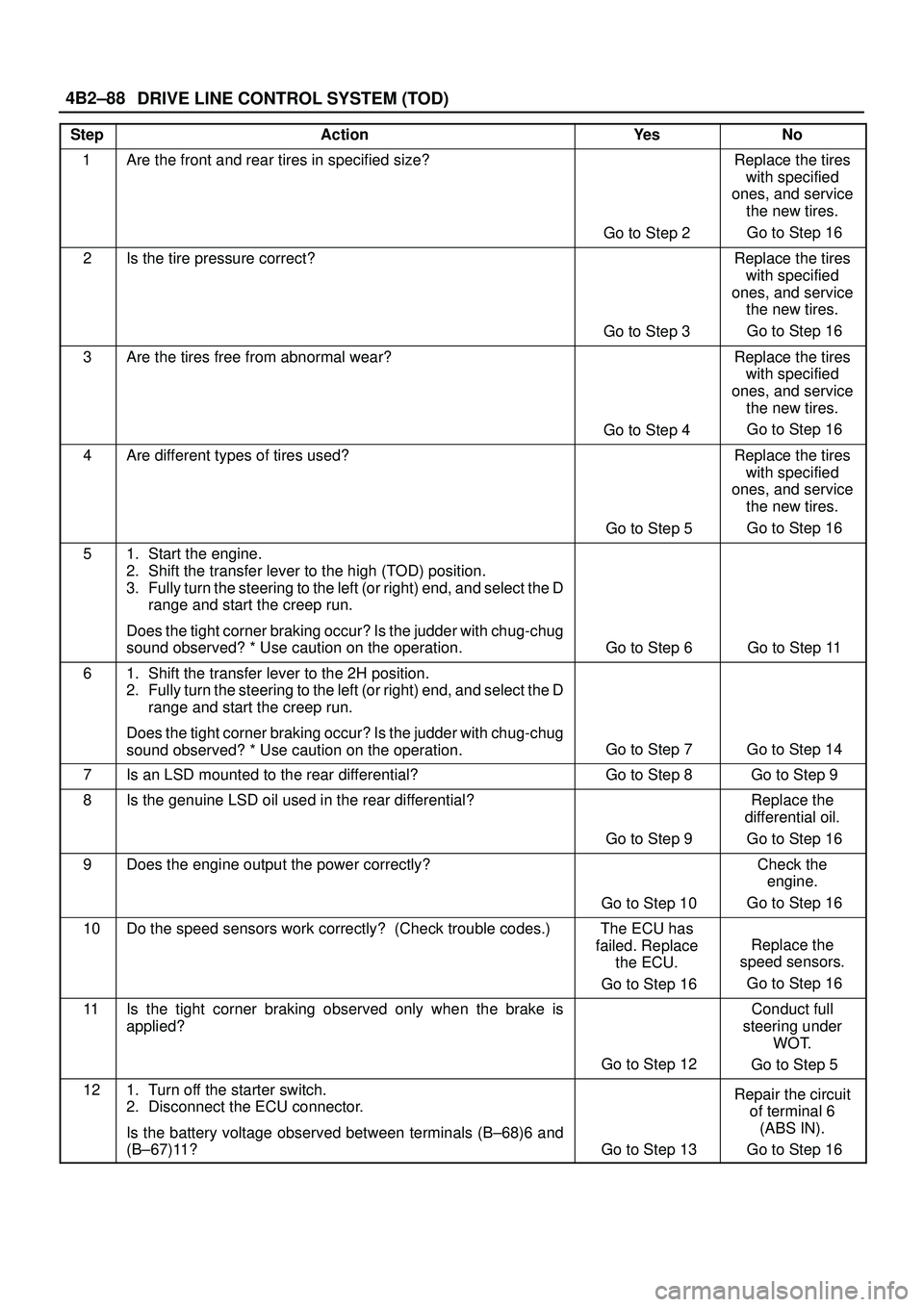
DRIVE LINE CONTROL SYSTEM (TOD) 4B2±88
StepActionYe sNo
1Are the front and rear tires in specified size?
Go to Step 2
Replace the tires
with specified
ones, and service
the new tires.
Go to Step 16
2Is the tire pressure correct?
Go to Step 3
Replace the tires
with specified
ones, and service
the new tires.
Go to Step 16
3Are the tires free from abnormal wear?
Go to Step 4
Replace the tires
with specified
ones, and service
the new tires.
Go to Step 16
4Are different types of tires used?
Go to Step 5
Replace the tires
with specified
ones, and service
the new tires.
Go to Step 16
51. Start the engine.
2. Shift the transfer lever to the high (TOD) position.
3. Fully turn the steering to the left (or right) end, and select the D
range and start the creep run.
Does the tight corner braking occur? Is the judder with chug-chug
sound observed? * Use caution on the operation.
Go to Step 6 Go to Step 11
61. Shift the transfer lever to the 2H position.
2. Fully turn the steering to the left (or right) end, and select the D
range and start the creep run.
Does the tight corner braking occur? Is the judder with chug-chug
sound observed? * Use caution on the operation.
Go to Step 7 Go to Step 14
7Is an LSD mounted to the rear differential? Go to Step 8 Go to Step 9
8Is the genuine LSD oil used in the rear differential?
Go to Step 9
Replace the
differential oil.
Go to Step 16
9Does the engine output the power correctly?
Go to Step 10
Check the
engine.
Go to Step 16
10Do the speed sensors work correctly? (Check trouble codes.)The ECU has
failed. Replace
the ECU.
Go to Step 16
Replace the
speed sensors.
Go to Step 16
11Is the tight corner braking observed only when the brake is
applied?
Go to Step 12
Conduct full
steering under
WOT.
Go to Step 5
121. Turn off the starter switch.
2. Disconnect the ECU connector.
Is the battery voltage observed between terminals (B±68)6 and
(B±67)11?
Go to Step 13
Repair the circuit
of terminal 6
(ABS IN).
Go to Step 16
Page 811 of 3573
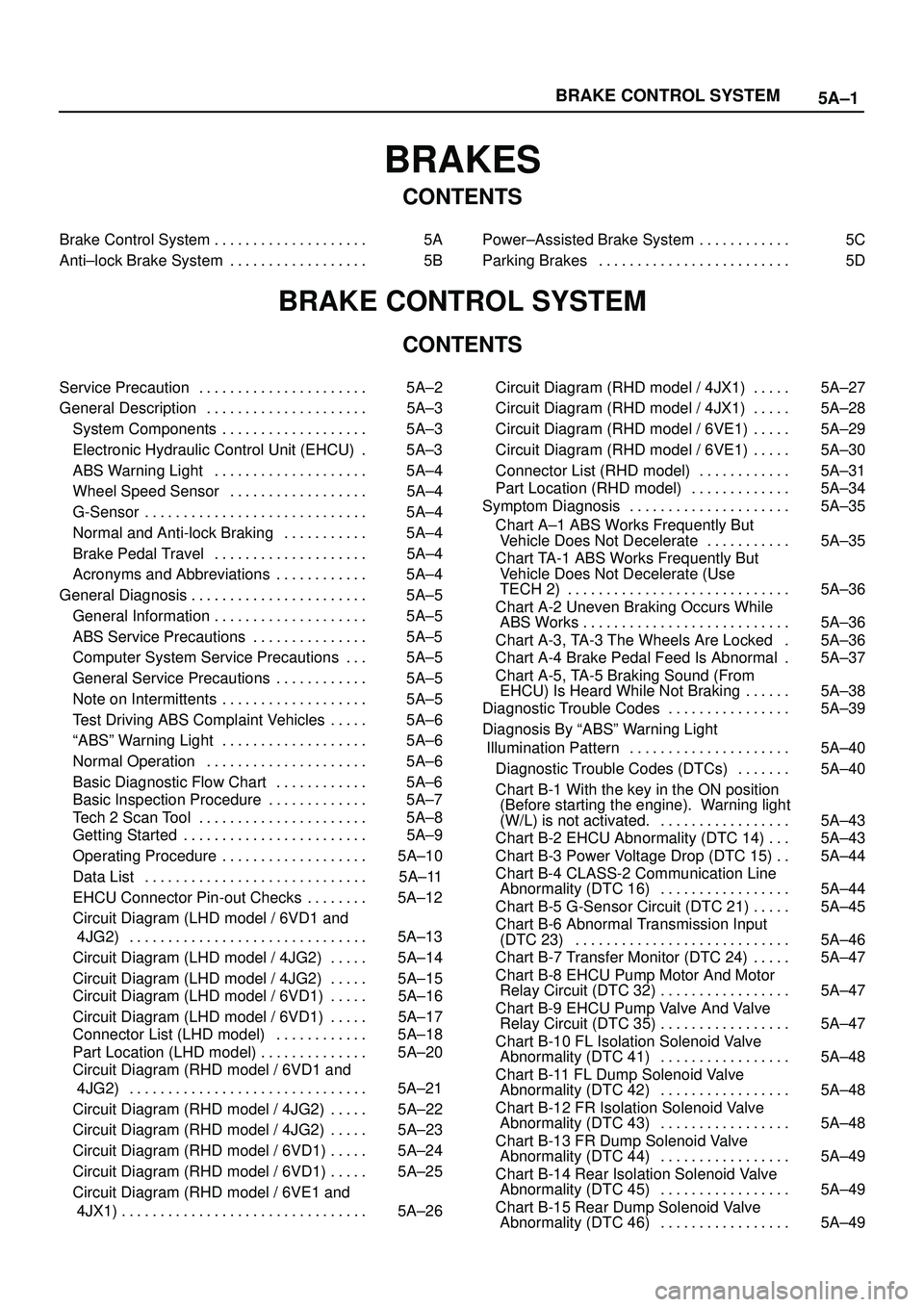
5A±1 BRAKE CONTROL SYSTEM
BRAKES
CONTENTS
Brake Control System 5A. . . . . . . . . . . . . . . . . . . .
Anti±lock Brake System 5B. . . . . . . . . . . . . . . . . . Power±Assisted Brake System 5C. . . . . . . . . . . .
Parking Brakes 5D. . . . . . . . . . . . . . . . . . . . . . . . .
BRAKE CONTROL SYSTEM
CONTENTS
Service Precaution 5A±2. . . . . . . . . . . . . . . . . . . . . .
General Description 5A±3. . . . . . . . . . . . . . . . . . . . .
System Components 5A±3. . . . . . . . . . . . . . . . . . .
Electronic Hydraulic Control Unit (EHCU) 5A±3.
ABS Warning Light 5A±4. . . . . . . . . . . . . . . . . . . .
Wheel Speed Sensor 5A±4. . . . . . . . . . . . . . . . . .
G-Sensor 5A±4. . . . . . . . . . . . . . . . . . . . . . . . . . . . .
Normal and Anti-lock Braking 5A±4. . . . . . . . . . .
Brake Pedal Travel 5A±4. . . . . . . . . . . . . . . . . . . .
Acronyms and Abbreviations 5A±4. . . . . . . . . . . .
General Diagnosis 5A±5. . . . . . . . . . . . . . . . . . . . . . .
General Information 5A±5. . . . . . . . . . . . . . . . . . . .
ABS Service Precautions 5A±5. . . . . . . . . . . . . . .
Computer System Service Precautions 5A±5. . .
General Service Precautions 5A±5. . . . . . . . . . . .
Note on Intermittents 5A±5. . . . . . . . . . . . . . . . . . .
Test Driving ABS Complaint Vehicles 5A±6. . . . .
ªABSº Warning Light 5A±6. . . . . . . . . . . . . . . . . . .
Normal Operation 5A±6. . . . . . . . . . . . . . . . . . . . .
Basic Diagnostic Flow Chart 5A±6. . . . . . . . . . . .
Basic Inspection Procedure 5A±7. . . . . . . . . . . . .
Tech 2 Scan Tool 5A±8. . . . . . . . . . . . . . . . . . . . . .
Getting Started 5A±9. . . . . . . . . . . . . . . . . . . . . . . .
Operating Procedure 5A±10. . . . . . . . . . . . . . . . . . .
Data List 5A±11. . . . . . . . . . . . . . . . . . . . . . . . . . . . .
EHCU Connector Pin-out Checks 5A±12. . . . . . . .
Circuit Diagram (LHD model / 6VD1 and
4JG2) 5A±13. . . . . . . . . . . . . . . . . . . . . . . . . . . . . . .
Circuit Diagram (LHD model / 4JG2) 5A±14. . . . .
Circuit Diagram (LHD model / 4JG2) 5A±15. . . . .
Circuit Diagram (LHD model / 6VD1) 5A±16. . . . .
Circuit Diagram (LHD model / 6VD1) 5A±17. . . . .
Connector List (LHD model) 5A±18. . . . . . . . . . . .
Part Location (LHD model) 5A±20. . . . . . . . . . . . . .
Circuit Diagram (RHD model / 6VD1 and
4JG2) 5A±21. . . . . . . . . . . . . . . . . . . . . . . . . . . . . . .
Circuit Diagram (RHD model / 4JG2) 5A±22. . . . .
Circuit Diagram (RHD model / 4JG2) 5A±23. . . . .
Circuit Diagram (RHD model / 6VD1) 5A±24. . . . .
Circuit Diagram (RHD model / 6VD1) 5A±25. . . . .
Circuit Diagram (RHD model / 6VE1 and
4JX1) 5A±26. . . . . . . . . . . . . . . . . . . . . . . . . . . . . . . . Circuit Diagram (RHD model / 4JX1) 5A±27. . . . .
Circuit Diagram (RHD model / 4JX1) 5A±28. . . . .
Circuit Diagram (RHD model / 6VE1) 5A±29. . . . .
Circuit Diagram (RHD model / 6VE1) 5A±30. . . . .
Connector List (RHD model) 5A±31. . . . . . . . . . . .
Part Location (RHD model) 5A±34. . . . . . . . . . . . .
Symptom Diagnosis 5A±35. . . . . . . . . . . . . . . . . . . . .
Chart A±1 ABS Works Frequently But
Vehicle Does Not Decelerate 5A±35. . . . . . . . . . .
Chart TA-1 ABS Works Frequently But
Vehicle Does Not Decelerate (Use
TECH 2) 5A±36. . . . . . . . . . . . . . . . . . . . . . . . . . . . .
Chart A-2 Uneven Braking Occurs While
ABS Works 5A±36. . . . . . . . . . . . . . . . . . . . . . . . . . .
Chart A-3, TA-3 The Wheels Are Locked 5A±36.
Chart A-4 Brake Pedal Feed Is Abnormal 5A±37.
Chart A-5, TA-5 Braking Sound (From
EHCU) Is Heard While Not Braking 5A±38. . . . . .
Diagnostic Trouble Codes 5A±39. . . . . . . . . . . . . . . .
Diagnosis By ªABSº Warning Light
Illumination Pattern 5A±40. . . . . . . . . . . . . . . . . . . . .
Diagnostic Trouble Codes (DTCs) 5A±40. . . . . . .
Chart B-1 With the key in the ON position
(Before starting the engine). Warning light
(W/L) is not activated. 5A±43. . . . . . . . . . . . . . . . .
Chart B-2 EHCU Abnormality (DTC 14) 5A±43. . .
Chart B-3 Power Voltage Drop (DTC 15) 5A±44. .
Chart B-4 CLASS-2 Communication Line
Abnormality (DTC 16) 5A±44. . . . . . . . . . . . . . . . .
Chart B-5 G-Sensor Circuit (DTC 21) 5A±45. . . . .
Chart B-6 Abnormal Transmission Input
(DTC 23) 5A±46. . . . . . . . . . . . . . . . . . . . . . . . . . . .
Chart B-7 Transfer Monitor (DTC 24) 5A±47. . . . .
Chart B-8 EHCU Pump Motor And Motor
Relay Circuit (DTC 32) 5A±47. . . . . . . . . . . . . . . . .
Chart B-9 EHCU Pump Valve And Valve
Relay Circuit (DTC 35) 5A±47. . . . . . . . . . . . . . . . .
Chart B-10 FL Isolation Solenoid Valve
Abnormality (DTC 41) 5A±48. . . . . . . . . . . . . . . . .
Chart B-11 FL Dump Solenoid Valve
Abnormality (DTC 42) 5A±48. . . . . . . . . . . . . . . . .
Chart B-12 FR Isolation Solenoid Valve
Abnormality (DTC 43) 5A±48. . . . . . . . . . . . . . . . .
Chart B-13 FR Dump Solenoid Valve
Abnormality (DTC 44) 5A±49. . . . . . . . . . . . . . . . .
Chart B-14 Rear Isolation Solenoid Valve
Abnormality (DTC 45) 5A±49. . . . . . . . . . . . . . . . .
Chart B-15 Rear Dump Solenoid Valve
Abnormality (DTC 46) 5A±49. . . . . . . . . . . . . . . . .
Page 814 of 3573
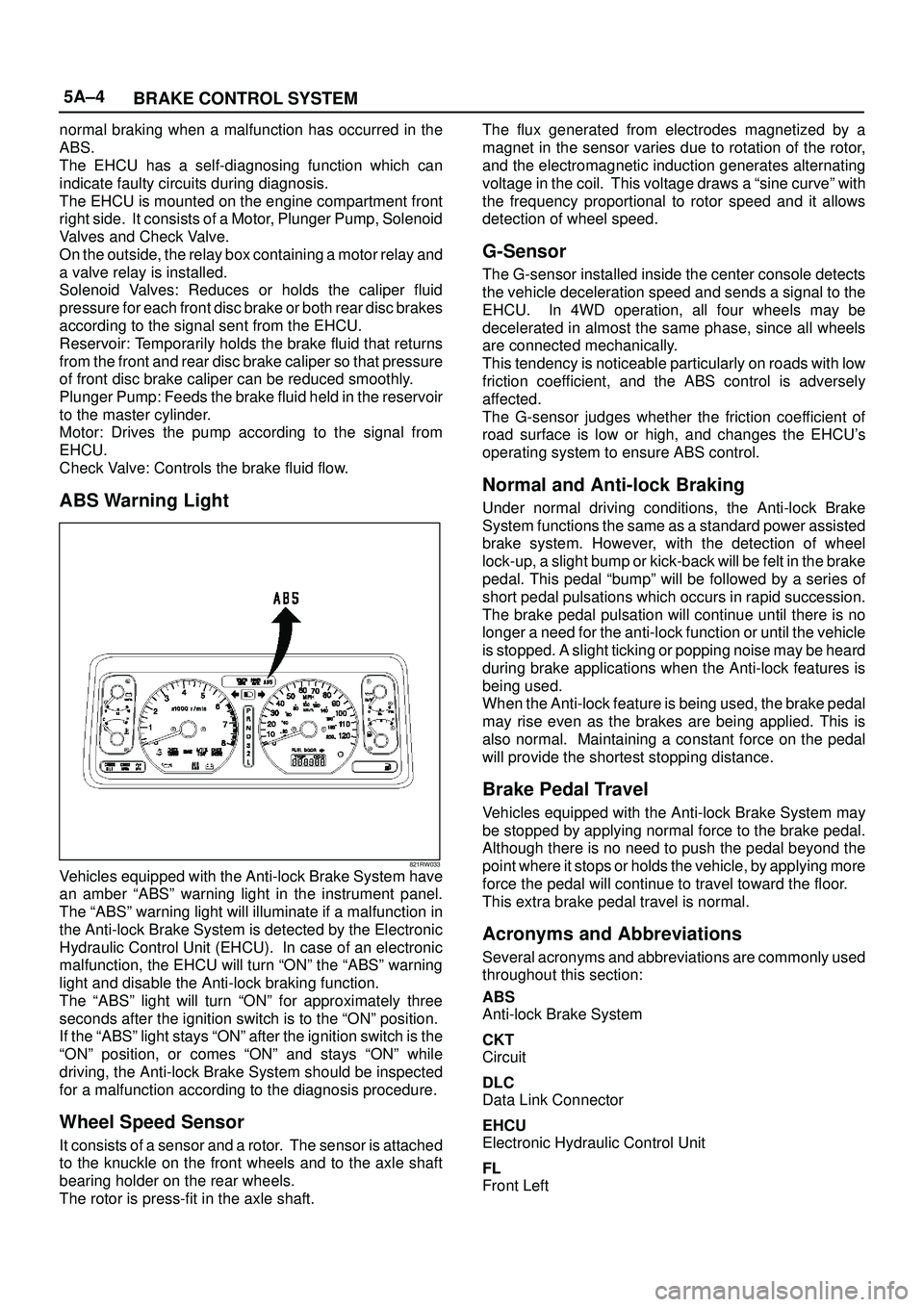
5A±4
BRAKE CONTROL SYSTEM
normal braking when a malfunction has occurred in the
ABS.
The EHCU has a self-diagnosing function which can
indicate faulty circuits during diagnosis.
The EHCU is mounted on the engine compartment front
right side. It consists of a Motor, Plunger Pump, Solenoid
Valves and Check Valve.
On the outside, the relay box containing a motor relay and
a valve relay is installed.
Solenoid Valves: Reduces or holds the caliper fluid
pressure for each front disc brake or both rear disc brakes
according to the signal sent from the EHCU.
Reservoir: Temporarily holds the brake fluid that returns
from the front and rear disc brake caliper so that pressure
of front disc brake caliper can be reduced smoothly.
Plunger Pump: Feeds the brake fluid held in the reservoir
to the master cylinder.
Motor: Drives the pump according to the signal from
EHCU.
Check Valve: Controls the brake fluid flow.
ABS Warning Light
821RW033Vehicles equipped with the Anti-lock Brake System have
an amber ªABSº warning light in the instrument panel.
The ªABSº warning light will illuminate if a malfunction in
the Anti-lock Brake System is detected by the Electronic
Hydraulic Control Unit (EHCU). In case of an electronic
malfunction, the EHCU will turn ªONº the ªABSº warning
light and disable the Anti-lock braking function.
The ªABSº light will turn ªONº for approximately three
seconds after the ignition switch is to the ªONº position.
If the ªABSº light stays ªONº after the ignition switch is the
ªONº position, or comes ªONº and stays ªONº while
driving, the Anti-lock Brake System should be inspected
for a malfunction according to the diagnosis procedure.
Wheel Speed Sensor
It consists of a sensor and a rotor. The sensor is attached
to the knuckle on the front wheels and to the axle shaft
bearing holder on the rear wheels.
The rotor is press-fit in the axle shaft.The flux generated from electrodes magnetized by a
magnet in the sensor varies due to rotation of the rotor,
and the electromagnetic induction generates alternating
voltage in the coil. This voltage draws a ªsine curveº with
the frequency proportional to rotor speed and it allows
detection of wheel speed.
G-Sensor
The G-sensor installed inside the center console detects
the vehicle deceleration speed and sends a signal to the
EHCU. In 4WD operation, all four wheels may be
decelerated in almost the same phase, since all wheels
are connected mechanically.
This tendency is noticeable particularly on roads with low
friction coefficient, and the ABS control is adversely
affected.
The G-sensor judges whether the friction coefficient of
road surface is low or high, and changes the EHCU's
operating system to ensure ABS control.
Normal and Anti-lock Braking
Under normal driving conditions, the Anti-lock Brake
System functions the same as a standard power assisted
brake system. However, with the detection of wheel
lock-up, a slight bump or kick-back will be felt in the brake
pedal. This pedal ªbumpº will be followed by a series of
short pedal pulsations which occurs in rapid succession.
The brake pedal pulsation will continue until there is no
longer a need for the anti-lock function or until the vehicle
is stopped. A slight ticking or popping noise may be heard
during brake applications when the Anti-lock features is
being used.
When the Anti-lock feature is being used, the brake pedal
may rise even as the brakes are being applied. This is
also normal. Maintaining a constant force on the pedal
will provide the shortest stopping distance.
Brake Pedal Travel
Vehicles equipped with the Anti-lock Brake System may
be stopped by applying normal force to the brake pedal.
Although there is no need to push the pedal beyond the
point where it stops or holds the vehicle, by applying more
force the pedal will continue to travel toward the floor.
This extra brake pedal travel is normal.
Acronyms and Abbreviations
Several acronyms and abbreviations are commonly used
throughout this section:
ABS
Anti-lock Brake System
CKT
Circuit
DLC
Data Link Connector
EHCU
Electronic Hydraulic Control Unit
FL
Front Left